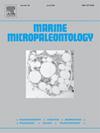Machine Learning for identification and classification of Foraminifera: Testing on monothalamids
IF 1.5
4区 地球科学
Q2 PALEONTOLOGY
引用次数: 0
Abstract
Here we propose an AI-based approach using machine learning (ML) to assist species identification and reduce morphotype redundancy in the study of monothalamous foraminifera. In fact, this group of protists, is often overlooked in taxonomic studies due to their morphological simplicity and diversity. These single-celled organisms with “soft” tests are poorly studied, with only a few species identified, while many morphotypes remain undescribed. Taxonomic research on monothalamids is limited by challenges in identification, lack of fossilization, and the time-intensive nature of the work. This gap may lead to underestimating biodiversity and hinder detecting ecosystem degradation. Despite these challenges, monothalamids play key roles in marine ecosystems, making their diversity crucial for conservation and resource management. With this in mind, we analyzed images from the scientific literature, extracting key morphological traits, such as chamber shape, shell type, composition, and aperture type, through objective human annotation to build a dataset processed by ML algorithms. Clustering techniques, such as K-Means, revealed that basic shape, followed by shell type and composition, were the primary features distinguishing clusters. This approach enabled more objective morphotype classification, improving consistency and reducing human bias.
These findings align with recent taxonomic revisions and demonstrate that applying unsupervised ML methods enhances species identification accuracy and streamlines the analysis of high-dimensional datasets.
有孔虫识别和分类的机器学习:单丘脑类的测试
在这里,我们提出了一种基于人工智能的方法,使用机器学习(ML)来帮助物种识别并减少单thalamous有孔虫研究中的形态冗余。事实上,这类原生生物由于其形态的简单和多样性,在分类学研究中经常被忽视。这些具有“软”测试的单细胞生物的研究很少,只有少数物种被确定,而许多形态仍然未被描述。单丘脑的分类学研究受到鉴定方面的挑战、缺乏化石和工作的时间密集性的限制。这一差距可能导致对生物多样性的低估,并阻碍对生态系统退化的检测。尽管存在这些挑战,单丘脑类在海洋生态系统中发挥着关键作用,使其多样性对养护和资源管理至关重要。考虑到这一点,我们分析了科学文献中的图像,通过客观的人工注释提取了关键的形态学特征,如腔室形状、壳类型、成分和孔径类型,构建了一个由ML算法处理的数据集。聚类技术,如K-Means,揭示了基本形状,其次是壳类型和组成,是区分聚类的主要特征。这种方法使形态学分类更加客观,提高了一致性,减少了人为偏见。这些发现与最近的分类学修订一致,并证明应用无监督机器学习方法可以提高物种识别的准确性,并简化高维数据集的分析。
本文章由计算机程序翻译,如有差异,请以英文原文为准。
求助全文
约1分钟内获得全文
求助全文
来源期刊

Marine Micropaleontology
地学-古生物学
CiteScore
3.70
自引率
15.80%
发文量
62
审稿时长
26.7 weeks
期刊介绍:
Marine Micropaleontology is an international journal publishing original, innovative and significant scientific papers in all fields related to marine microfossils, including ecology and paleoecology, biology and paleobiology, paleoceanography and paleoclimatology, environmental monitoring, taphonomy, evolution and molecular phylogeny. The journal strongly encourages the publication of articles in which marine microfossils and/or their chemical composition are used to solve fundamental geological, environmental and biological problems. However, it does not publish purely stratigraphic or taxonomic papers. In Marine Micropaleontology, a special section is dedicated to short papers on new methods and protocols using marine microfossils. We solicit special issues on hot topics in marine micropaleontology and review articles on timely subjects.
 求助内容:
求助内容: 应助结果提醒方式:
应助结果提醒方式:


